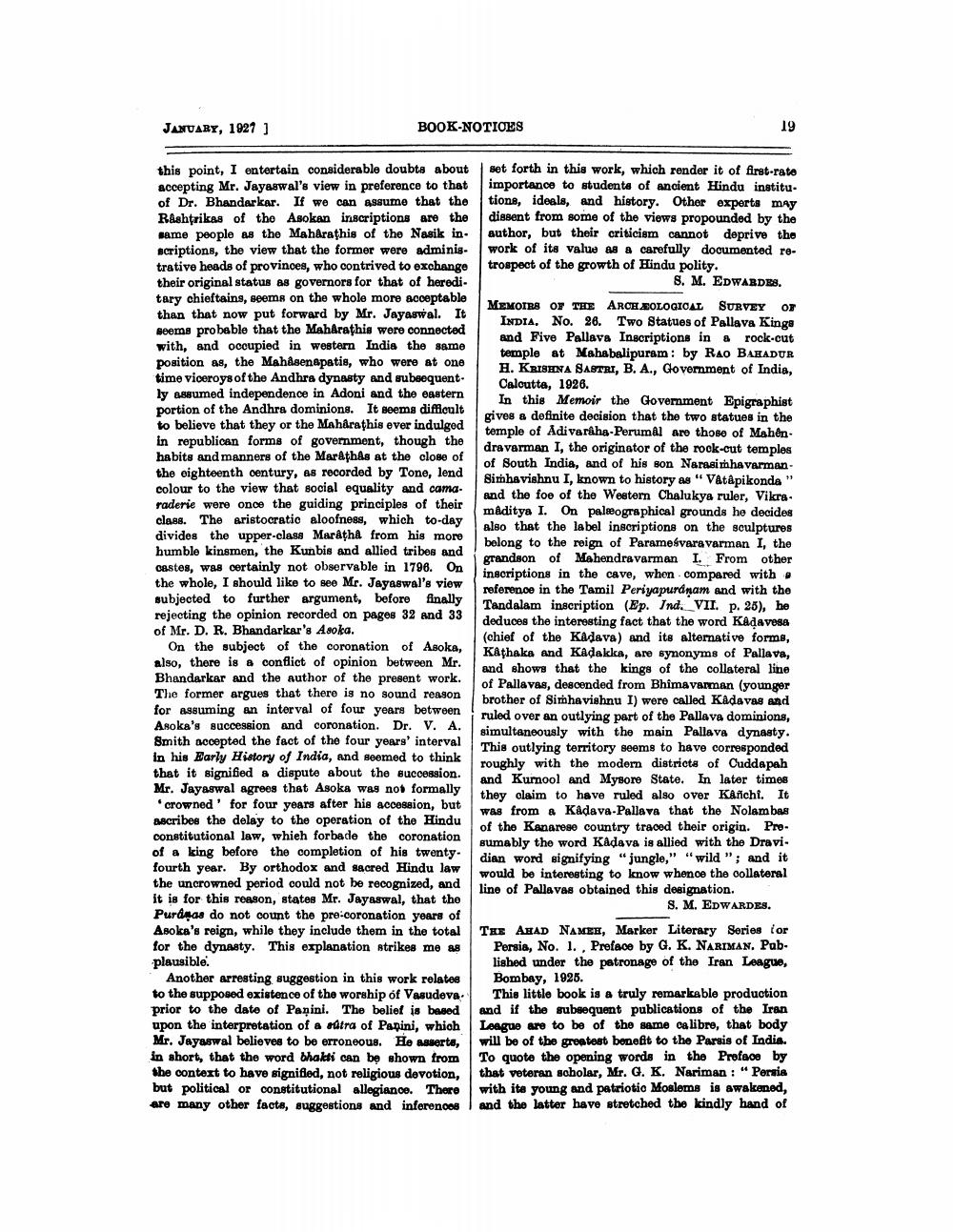________________
JANUARY, 1927 ]
this point, I entertain considerable doubts about accepting Mr. Jayaswal's view in preference to that of Dr. Bhandarkar. If we can assume that the Rashtrikas of the Asokan inscriptions are the same people as the Maharathis of the Nasik inscriptions, the view that the former were administrative heads of provinces, who contrived to exchange their original status as governors for that of hereditary chieftains, seems on the whole more acceptable than that now put forward by Mr. Jayaswal. It seems probable that the Maharathis were connected with, and occupied in western India the same position as, the Mahasenapatis, who were at one time viceroys of the Andhra dynasty and subsequently assumed independence in Adoni and the eastern portion of the Andhra dominions. It seems difficult to believe that they or the Maharathis ever indulged in republican forms of government, though the habits and manners of the Marathâs at the close of the eighteenth century, as recorded by Tone, lend colour to the view that social equality and camaraderie were once the guiding principles of their class. The aristocratic aloofness, which to-day divides the upper-class Maratha from his more humble kinsmen, the Kunbis and allied tribes and castes, was certainly not observable in 1796. On the whole, I should like to see Mr. Jayaswal's view subjected to further argument, before finally rejecting the opinion recorded on pages 32 and 33 of Mr. D. R. Bhandarkar's Asoka.
BOOK-NOTICES
On the subject of the coronation of Asoka, also, there is a conflict of opinion between Mr. Bhandarkar and the author of the present work. The former argues that there is no sound reason for assuming an interval of four years between Asoka's succession and coronation. Dr. V. A. Smith accepted the fact of the four years' interval in his Early History of India, and seemed to think that it signified a dispute about the succession. Mr. Jayaswal agrees that Asoka was not formally 'crowned' for four years after his accession, but ascribes the delay to the operation of the Hindu constitutional law, whieh forbade the coronation of a king before the completion of his twentyfourth year. By orthodox and sacred Hindu law the uncrowned period could not be recognized, and it is for this reason, states Mr. Jayaswal, that the Puranas do not count the pre-coronation years of Asoka's reign, while they include them in the total for the dynasty. This explanation strikes me as plausible.
Another arresting suggestion in this work relates to the supposed existence of the worship of Vasudeva. prior to the date of Panini. The belief is based upon the interpretation of a sútra of Papini, which Mr. Jayaswal believes to be erroneous. He asserts, in short, that the word bhakti can be shown from the context to have signified, not religious devotion, but political or constitutional allegiance. There are many other facts, suggestions and inferences
19
set forth in this work, which render it of first-rate importance to students of ancient Hindu institutions, ideals, and history. Other experts may dissent from some of the views propounded by the author, but their criticism cannot deprive the work of its value as a carefully documented retrospect of the growth of Hindu polity. S. M. EDWARDES.
MEMOIRS OF THE ARCHEOLOGICAL SURVEY OF INDIA. No. 26. Two Statues of Pallava Kings and Five Pallava Inscriptions in a rock-cut temple at Mahabalipuram: by RAO BAHADUR H. KRISHNA SASTRI, B. A., Government of India, Calcutta, 1926.
In this Memoir the Government Epigraphist gives a definite decision that the two statues in the temple of Adivarâha-Perumal are those of Mahêndravarman I, the originator of the rock-cut temples of South India, and of his son NarasimhavarmanSimhavishnu I, known to history as "Vatapikonda " and the foe of the Western Chalukya ruler, Vikra. maditya I. On paleographical grounds he decides also that the label inscriptions on the sculptures belong to the reign of Paramesvara varman I, the grandson of Mahendravarman I. From other inscriptions in the cave, when compared with reference in the Tamil Periyapuranam and with the Tandalam inscription (Ep. Ind. VII. p. 25), he deduces the interesting fact that the word Kaḍavesa (chief of the Kadava) and its alternative forms, Kathaka and Kadakka, are synonyms of Pallava, and shows that the kings of the collateral line of Pallavas, descended from Bhimavarman (younger brother of Simhavishnu I) were called Kâdavas and ruled over an outlying part of the Pallava dominions, simultaneously with the main Pallava dynasty. This outlying territory seems to have corresponded roughly with the modern districts of Cuddapah and Kurnool and Mysore State. In later times they claim to have ruled also over Kâñchi. It was from a Kadava-Pallava that the Nolambas of the Kanarese country traced their origin. Presumably the word Kadava is allied with the Dravi. dian word signifying "jungle," "wild"; and it would be interesting to know whence the collateral line of Pallavas obtained this designation.
S. M. EDWARDES.
THE AHAD NAMEH, Marker Literary Series for Persia, No. 1., Preface by G. K. NARIMAN. Published under the patronage of the Iran League, Bombay, 1925.
This little book is a truly remarkable production and if the subsequent publications of the Iran League are to be of the same calibre, that body will be of the greatest benefit to the Parsis of India. To quote the opening words in the Preface by that veteran scholar, Mr. G. K. Nariman: "Persia with its young and patriotic Moslems is awakened, and the latter have stretched the kindly hand of




